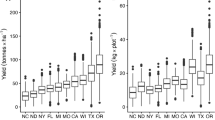Summary
Long-term persistence and, hence, agronomic success as a pasture of the annual species subterranean clover depend primarily on seed yield and seed survival over seasons. In natural populations, plant characteristics influencing seed setting and formation of seed reserves in the soil are expected to be ‘adjusted’ to the prevailing environmental conditions of the sites of origin. Knowledge on plant/environment relationships may provide information on adaptive strategies of persistence, and guidelines for selecting adapted varieties to specific conditions. On pure lines from a number of populations such relationships were assessed for flowering time, seed yield, burr fertility, individual seed weight, initial hardseededness, and rate of hardseededness breakdown over summer. Flowering time decreased on decreasing annual rainfall, i.e., on shortening the growing season, as adaptive response to the need of producing adequate seed before the onset of the dry season. Individual seed weight decreased on decreasing rainfall, and increasing temperatures. Hard-seed maintenance over summer was higher in populations from hot and dry environments, where the marked effect of temperature on hardseededness breakdown exerts a strong selective pressure. Within-population variation, assessed on flowering time, was particularly wide, with early genotypes occurring even in populations from long-season environments. The adaptive relevance of maintaining high levels of within-population polymorphism to cope with unpredictable climatic fluctuations is discussed. Number of constituent lines as a measure of the population structure, and intra-population variation were both influenced by altitude and rainfall, tending to decrease as the climatic selective pressure becomes severe, under both low-rainfall, hot conditions and high-elevation, cold-prone environments.
Similar content being viewed by others
References
Buddenhagen I.W., 1990. Legumes in farming systems in Mediterranean climates. In: A.E. Osman, M.H. Ibrahim & M.A. Jones (Eds). The role of legumes in the farming systems of the Mediterranean areas. p. 3–29 Kluwer Academic Publishers, Dordrecht.
Francis C.M. & J.S. Gladstones, 1974. Relationships among rate and duration of flowering and seed yield components in subterranean clover (Trifolium subterraneum). Aust J Agric Res 25: 435–442.
Katznelson J., 1974. Biological flora of Israel. 5. The subterranean clovers of Trifolium subsect. Calycomorphum Katzn. Trifolium subterraneum L. (sensu lato). Isr J Bot 23: 69–108.
Marshall D.R. & P. Broué, 1973. Outcrossing rates in Australian populations of subterranean clover. Aust J Agric Res 24: 863–867.
Pecetti L. & E. Piano, 1994. Observations on the rapidity of seed and burr growth in subterranean clover. J Genet & Breed 48: 225–228.
Piano E., 1984. Preliminary observations on the structure and variability of Sardinian populations of subterranean clover. Genet Agr 38: 75–90.
Piano E., F. Spanu & L. Pecetti, 1993. Structure and variation of subterranean clover populations from Sicily, Italy. Euphytica 68: 43–51.
Quinlivan B.J., 1971. Seed coat impermeability in legumes. J Aust Inst Agric Sci 37: 283–295.
Quinlivan B.J. & C.M. Francis, 1971. The effect of burr burial on the seed of some early maturing subterranean clover cultivars. Aust J Exp Agric Anim Husb 11: 35–38.
Rossiter R.C., 1966. The success or failure of strains of Trifolium subterraneum L. in a Mediterranean environment. Aust J Agric Res 17: 425–446.
Rossiter R.C., 1978. The ecology of subterranean clover-based pastures. In: J.R. Wilson (Ed.). Plant relations in pastures. p. 325–339. CSIRO, Melbourne.
Russi L., P.S. Cocks & E.H. Roberts, 1992. Coat thickness and hard-seededness in some Medicago and Trifolium species. Seed Sci Res 2: 243–249.
Taylor G.B., 1981. Effect of constant temperature treatments followed by fluctuating temperatures on the softening of hardseeds of Trifolium subterraneum L. Aust J Plant Physiol 8: 547–558.
Author information
Authors and Affiliations
Rights and permissions
About this article
Cite this article
Piano, E., Pecetti, L. & Carroni, A.M. Climatic adaptation in subterranean clover populations. Euphytica 92, 39–44 (1996). https://doi.org/10.1007/BF00022826
Issue Date:
DOI: https://doi.org/10.1007/BF00022826




